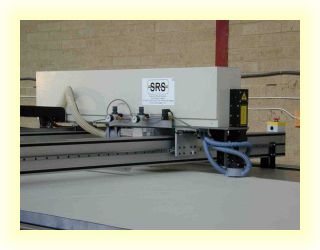| Spectrum Robotic Systems Ltd | ||
The 2000 series is one of our best selling cutting systems. The versatility of a laser is unmatched. For applications from paper cutting through sailmaking materials to cutting steel. Powers of laser range from 10 to 2500 watts. With laser power control so sophisticated that one sheet of paper can be cut, with another underneath untouched. Attributes of laser cutting are: Higher speed processing than other tools, sealing of all cut edges, narrow kerf width and versatility.
Typical applications include: Sailmaking, Hangliders, Paragliders, Balloons, Airships, Filter media, Fabric Structures, Tents, Clothing, Shoes, Parachutes. Overview Laser cutting is a very versatile cutting method with very accurate power control and high cut speeds possible. It is used in many industries in the manufacture of such products as sails, balloons, airships, tents, clothing, a wide range fabrics, and many more. The 2000 Series Laser Knife is currently the most popular of Spectrum’s cutting systems, mainly due to its many advantages and wide-ranging customer base. The operation of this system is the same as that of Spectrum’s other cutting systems. It features user friendly front-end software that makes production an extremely simple task. Utilizing on screen overlays and allowing varied setup configurations, relating to different cut jobs or materials, to be stored – the software saves time and effort which can be better spent elsewhere. Upon commencement of a cut, the software commands the motion system to move to the start position, open the laser shutter and then follow the programmed cut path accurately to within 0.25mm. At the same time, the laser controller is monitoring the speed of the motion and adjusting the power of the laser accordingly. Therefore, the process requires no user interaction from the moment of initialization. Spectrum utilize different types and manufacturers of laser, depending upon the application and location of the system. Laser units range from 25 watt to 3000 watt The power can then be set anywhere up to the laser’s maximum capability. Different laser types work on different principles but ultimately in a similar lasing fashion. With an electricaly excited laser, an electrical voltage is passed between electrodes in a sealed tube filled with gas. The laser gas is excited, creating light of a certain wavelength. This light is called a photon. As the photons travel faster and faster within the tube, a few photons are allowed a controlled escape and are focussed and directed onto the material to be cut. With an RF excited laser, high frequency is used to excite the lasing gas with the same result as above.
|
||
|
||
